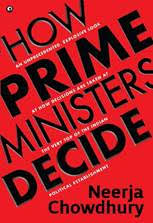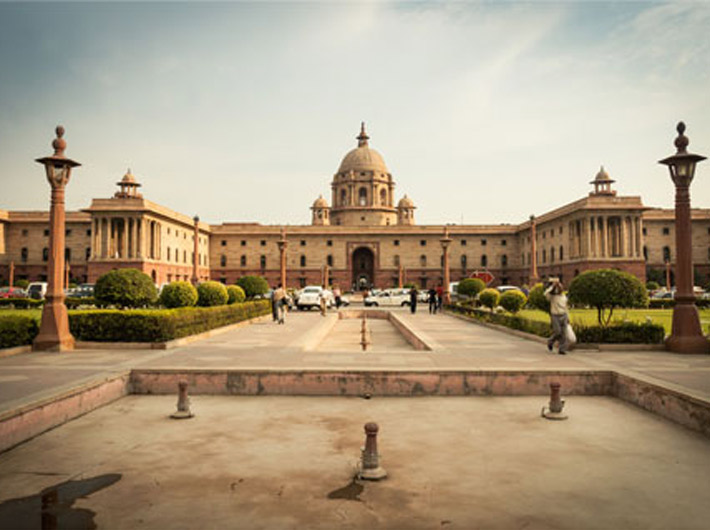Excerpt from Neerja Chowdhury’s riveting and explosive ‘How Prime Ministers Decide’
How Prime Ministers Decide
By Neerja Chowdhury
Aleph, 608 pages, Rs 999

If there is one person who influences India’s history-in-the-making the most, it has to be the prime minister. While there have been notable biographies of several prime ministers, there was no book on the working of the PM – how he (or she), lonely at the top, responds to the pulls and pressures or to emerging developments, and makes decisions. Neerja Chowdhury, among the most respected veteran political reporters/commentators, has written that book, and it turns out to be “an unprecedented, explosive look at how decisions are taken at the very top of the Indian political establishment”.
The book goes beyond the news headlines to provide an eye-opening account of how some of the most important political decisions in independent India were taken. The author analyses the operating styles of the country’s PMs through the prism of six decisions of historic significance. These are as follows:
* The strategy that Indira Gandhi devised to return to power in 1980, after her humiliating defeat post the Emergency in 1977;
* The errors of judgment that led Rajiv Gandhi to undo the Supreme Court’s judgment in the Shah Bano case;
* V. P. Singh’s implementation of the Mandal Commission Report to save his government which forever changed the face of contemporary politics;
* P. V. Narasimha Rao’s masterful indecision that resulted in the demolition of the Babri Masjid;
* The rapidly changing political scenarios that turned the avowed pacifist Atal Bihari Vajpayee into a nuclear hawk who greenlighted the testing of nuclear devices; and
* The mild and professorial Manmohan Singh, widely regarded as one of the country’s weakest prime ministers, who defied interest groups and foes within the political establishment to seal a historic nuclear deal with the United States—and upgraded the bilateral relationship to a new level.
Based on hundreds of interviews that the author conducted with prime ministers, key figures in the political establishment, bureaucrats, aides, policymakers, and even fixers—the book provides remarkable insights that have been gleaned over forty years of high-level reporting on the national political scene.
‘How Prime Ministers Decide’ is an unparalleled book about modern Indian politics which will change the way we view how prime ministers govern the country.
Here is an excerpt from the introduction:
Prime Minister’s Office (PMO)
Powerful PMs, like Indira Gandhi and Narendra Modi, have chosen to rule through the Prime Minister’s Office (PMO). The PMO is as powerful as the prime minister wants it to be. For all the challenges he faced to get a new nation up and running, Jawaharlal Nehru had a low-profile Prime Minister’s Secretariat (PMS) now known as the PMO. Nehru’s PMS had only a joint secretary level officer heading it—M. O. Mathai, who was private secretary to Nehru. Mathai became famous later when he fell out with the Nehrus and wrote a sensational tell-all book about the family. Though Nehru had little challenge to his authority after the death of Sardar Patel in 1950, he preferred to work through his cabinet ministers.
Leaders in their own right during the freedom movement, they could act relatively more independently than was the case in later years. It was the more diffident Lal Bahadur Shastri who felt the need for a senior officer to take care of his office, and brought in L. K. Jha as secretary in the PMS. Jha, an ICS officer, looked after all aspects of the prime minister’s functioning and came to wield more power than the cabinet secretary, who is the head of the bureaucracy. It was Jha who convinced Shastri to go to Tashkent to engage with Pakistan after the 1965 war between the two countries.
Indira Gandhi was the first leader to make the PMS all powerful. She first deputed a deputy minister, Dinesh Singh to take charge of it. In 1967, she appointed the powerful P. N. Haksar as secretary in the PMS; in 1971, he became her principal secretary. The left-leaning Haksar was not just the implementer of her instructions, he also influenced all her major policy decisions between 1967–72 from bank nationalization to helping create the new nation of Bangladesh. Haksar, who knew Indira since their days in Allahabad, would call her Indu in private. But in public she was prime minister.
The PMS became the PMO during Morarji Desai’s premiership. The self-sufficient Desai did not feel the need for it; he downgraded it and it dealt mostly with problems of coalition management. The wily P. V. Narasimha Rao did not feel the need to rely on a single official or a coterie. Though Amar Nath Verma was his principal secretary, Rao used Naresh Chandra for unorthodox tasks—as the head of the Ayodhya Cell to find a way out of the temple tangle, and then as his point person with the scientists to ready for a nuclear test in 1995.
Since Independence, there have been two really powerful principal secretaries who indisputably influenced the decision-making of prime ministers. They were P. N. Haksar and Brajesh Mishra, Vajpayee’s principal secretary. Mishra, also the national security advisor, was often called the de facto head of the government. Vajpayee did not involve himself in the nuts and bolts of decision-making. He left these to Mishra.
Manmohan Singh’s PMO was ‘unpretentious’ and ‘subdued’, in sync with his own personality. Singh would hardly speak even in cabinet meetings, and ran his government through Groups of Ministers (GoMs) and Empowered Groups of Ministers (EGoMs), many of them were headed by the experienced Pranab Mukherjee. But it was Sonia Gandhi who was the real centre of power in the UPA government Singh led; she worked through her political secretary, Ahmed Patel.
Narendra Modi governs through his PMO, which oversees the functioning of every ministry. The PMO sets the agenda for the ministries—ministers implement programmes that they are instructed to carry out. The exception is the home minister, Amit Shah, who plays a significant role in decision-making at the top. Modi’s principal secretary, Nripendra Mishra, Nippy to friends, who held office for the first five years of Modi’s first term as PM (from 2014–19), and then P. K. Mishra who replaced him, were neither as powerful as P. N. Haksar or Brajesh Mishra nor asvisible—and they preferred to keep a low profile. A powerful figure in Modi’s PMO, and a man who had the prime minister’s confidence, was his national security advisor, Ajit Doval. But Doval too chooses to remain under the radar.
*
Beyond the official powers conferred on prime ministers by the Constitution, there are many informal ways in which they can checkmate those who oppose them.
Prime ministers are known to keep dossiers on their opponents, rivals, and potential challengers. Some PMs accepted that these dossiers exist. But they were quick to add that they themselves never used the information against their opponents. ‘Yes, there are dossiers,’ Chandra Shekhar had told me. ‘I never used them. I only got information from the IB. I was told that even in Indira Gandhi’s time, they were not used. Their mere presence was enough.’
‘There are...files in the PMO on politicians and leading bureaucrats and many other important people. They are kept under lock and key with the PMO,’ revealed Bhuvnesh Chaturvedi, minister of state in P. V. Narasimha Rao’s PMO. ‘They contain information about corruption, women, and all kinds of misdoings.’ He added: ‘The practice was started during Indira Gandhi’s time. And it was the Research and Analysis Wing (R&AW)—though it was meant to collect external intelligence—(which) helped put it together.... She was apprehensive about her position.’ Most prime ministers would have wanted to keep their adversaries on a leash.
[The excerpt reproduced with the permission of the publishers.]
